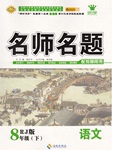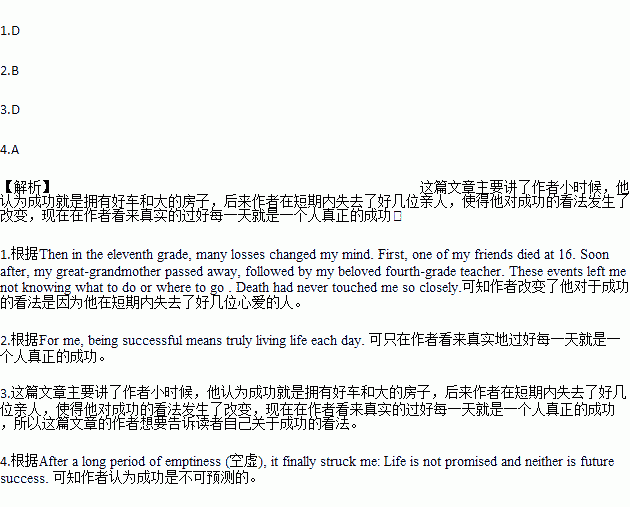题目内容
When I was young, I wished for a good car and a big house. That was my idea of success. I took all the advanced classes and tried to do well in the exams with my mind set on going to a key school. I just knew that I would somehow become famous and be able to afford the car and the dream house. All the way through junior years, my mind was planning this beautiful future.
Then in the eleventh grade, many losses changed my mind. First, one of my friends died at 16. Soon after, my great-grandmother passed away, followed by my beloved fourth-grade teacher. These events left me not knowing what to do or where to go . Death had never touched me so closely.
After a long period of emptiness (空虚), it finally struck me: Life is not promised and neither is future success. Though I was attempting to achieve material success, I was not enjoying my daily life. I realized that finding inner peace, purpose and happiness will stick with me forever and that is real success.
Enjoying life's precious quirks ( 偶发事件 ) makes an ordinary person more successful than a wealthy person who isn't content and takes everything for granted. The summer before senior years, my attitude changed greatly. Instead of memorizing facts, I began learning skills. Instead of focusing on the future, I focused on today and the many blessings and successes that came with it.
I still get excellent grades, but now I devote weeks to studying instead of struggling for exams, and I think about the future with a deeper sense of meaning. For me, being successful means truly living life each day.
1.The reason why the author changed his idea of success is that ________ .
A. he can't afford his house
B. his beloved teacher was dead
C. he didn't know what to do or where to go
D. he lost a few beloved persons in a short time
2.According to the author which of the following is the real success for a person?
A. Being famous. B. Truly living life each day.
C. Good car and big house. D. Material achievements.
3.What does the author want to tell the readers?
A. The true meaning of the life. B. The true meaning of studying.
C. How to achieve success. D. His opinion about success.
4.According to the passage, which of the following is true?
A. The writer thinks that success is not promised.
B. His teacher died before the death of his grandpa.
C. The writer didn't do well in all the exams.
D. He didn't want to take all the exams.
 优学名师名题系列答案
优学名师名题系列答案

 5' sheet of clear or slightly milky plastic, six feet of plastic tube, and a container— perhaps just a drinking cup — to catch the water. These pieces can be folded into a neat little pack and fastened on your belt.
5' sheet of clear or slightly milky plastic, six feet of plastic tube, and a container— perhaps just a drinking cup — to catch the water. These pieces can be folded into a neat little pack and fastened on your belt. powerful story of brotherhood, bravery and understanding carried out.
powerful story of brotherhood, bravery and understanding carried out. nd and is famous for its six-lane highways.
nd and is famous for its six-lane highways.